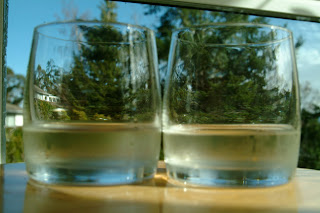Every Bartender would agree that ice is a essential ingredient in any cold drink. Most bartenders would also agree that size matters and can make a dramatic difference. Small ice equals more surface area therefore more dilution and the opposite applying for larger ice. So any time I stir up an Old Fashioned I ensure to pour it over a nice big ice ball. There has already been so much said about ice that talking about using big, "fresh" ice free of any other freezer odorous wouldn't been anything new, but what about the practice of using ice free of any impurities? It seems as of lately some bars have been taking on the task of making their ice as clear and the glass you're drinking from. The process is simple enough, boil water, let cool, repeat and freeze. But what other positives asides from presentation does this pellucid ice yield? I took the time and double boiled some filtered water. I froze two sets of ice cube trays, one of double boiled filtered water and one of just filtered water as well as a set of ice balls. As you can see in the pictures below there wasn't a substantial difference between the two cubes. The filtered cube was approximately between 60-65% clear and the double boiled cube was about 75-80% clear.
 |
The glass on the left is vermouth stirred with the filtered ice and the glass on the right was stirred with double boiled ice. As you can see there is a noticable difference in the volume of liquid but very negligible. So the only thing to do now is to taste it. And was there a difference in taste? The short answer is no, nor was there any noticeable difference in temperature. The difference in taste was so insignificant that if you had two cocktails one after another, one being stirred with filter ice and the other with double boiled ice you would have not a clue the difference. I then placed two ice balls in each glass and let them sit for 3 hours. The final product of ice wasn't that different as you can see.
 |
| Filtered Ice ball left. Double Boiled Ball Right. |
There was although a drastic difference in the beginning product of the ice balls. The double boiled ball was approximately 60-70% clear where as the filter ice was 15% at best. So I thought, no one is going to be sipping vermouth through a straw from their undisturbed glass for 3 hours. So for the sake of "Science" I painfully prepared two Old Fashioneds in the same fashion as the vermouth. The double boiled ball seemed to stay in one piece for the entirety of the swim, unfortunately the filtered ball didn't fare as well. Small ice chunks cracked off and eventually the entire sphere split in two and thus watering down the drink more then it's opponent.
So what's the end verdict? In my opinion( keyword being "my", I am by no means a scientist or even a bartender) for small ice cubes, filtered water will suffice. I do how ever think it makes a difference for big ice, whether you're freezing big blocks for cracking or just single spheres for sipping the dilution rate appears to be much slower then good ol' filtered water. But remember this was clearly an experiment for my own pleasure and I thought it would make a good topic to blog about. If you want to read a blog post about ice from a guy that REALLY knows what he's talking about check out Dave Arnold's (who happens to be a real scientist!) blog post on ice.








